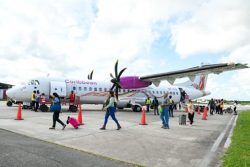As with its state of unreadiness at the onset of the catastrophic flood of 2005, the Civil Defence Commission’s capacity to cope with an aviation calamity in this country is practically non-existent. Aircraft pilots, tour operators and other hinterland businessmen are sick and tired of the current adhocery and of repeatedly appealing to the administration to put search and rescue operations on a proper and permanent footing.
The nature and extent of the forested and mountainous terrain; absence of navigational aids; and unpredictably turbulent weather conditions – particularly in December-January and May-June every year – have been contributory factors to aircraft crashes. These conditions suggest that the administration should be concerned about public safety.
Despite the growing demand for domestic air travel between the coastland and hinterland as a result of tourist visits, the movement of government officials and residents, mining and other businesses, however, there has been no serious attempt to support the aviation sector with an efficient search and rescue service that is equipped to respond promptly to emergencies.
It was at this time of the year in January 2001 that the Guyana Defence Force lost its last Britten-Norman Islander aircraft which crashed in the Potaro-Siparuni region, killing two flying officers and a civilian passenger. In April last year, also, three persons, including the pilot, were killed in the crash of an Air Services Limited Britten-Norman aircraft, again in the chancy Potaro-Siparuni region.
The Aircraft Owners Association of Guyana Inc has repeatedly criticised the state of search and rescue operations in a country not only dependent on its aviation services for hinterland development but also deficient in the most elemental air traffic control and navigation aids in those areas.
Most of the hinterland’s six dozen legal airstrips are unmonitored – a problem not only for safety since legitimate pilots might be unaware of the flight paths of foreign aircraft, but also for national security as they could be used by narco-traffickers and gun-runners. Serious investors and entrepreneurs are unlikely to be attracted to the wild, western Essequibo where travel safety cannot be assured by the central government.
Hinterland flying could be made safer, lives can be saved and lost confidence can be restored. Part of the way forward could be to establish an efficient national search and rescue organisation, perhaps under the Civil Defence Commission, and to enhance aviation navigation resources under the Civil Aviation Authority to support the country’s aviation sector countrywide.
The search and rescue organisation would require, at a minimum, the availability of a team of rescuers, most likely from the defence force, who are trained in parachuting, rappelling, emergency medicine and jungle operations; access to an airworthy helicopter equipped with hoisting and rappelling capabilities and forward looking infra-red equipment to locate crashed aircraft by heat; aero-medical and casualty evacuation equipment to rescue survivors; and efficient land, river and air transport.
This is not pie in the sky. Captain Gerry Gouveia told this newspaper that the Guyana Defence Force Air Corps used to have this capability twenty-five years ago. In those days, the Air Corps, private aircraft owners, Ministry of Health and the Civil Aviation Department were capable of providing some sort of a search and rescue service. That competence seems to have been lost along with the Air Corps’ fleet and official interest.
The United States government, to which appeals for assistance are usually directed once a disaster occurs, conducted a series of public safety, security and medical response courses in July 2006. Facilitators from the St Croix Rescue Academy undertook medical and search and rescue training to enhance this country’s scant emergency and disaster preparedness capability. This is good but far from sufficient; inevitably, its value will be lost without a permanent organisation to sustain it.
There is little indication that in the short and middle terms the administration would either evince interest in, or capability of, markedly improving the efficiency of aviation or road transport to the hinterland. This means that there will continue to be heavy reliance on a large number of aircraft to carry a large volume of cargo and passengers between the coastland and hinterland.
Lack of preparation for safety has a way of leading to calamity.





